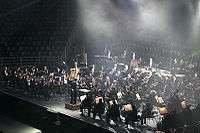Music appreciation

In North America, music appreciation courses often focus on Western art music, commonly called "Classical music". Usually music appreciation classes involve some history lessons to explain why people of a certain era liked the music that they did.[1] "Appreciation," in this context, means the understanding of the value and merit of different styles of music. Music appreciation classes also typically include information about the composers, the instruments and ensembles, and the different styles of music from an era. Music appreciation courses are widely available in universities and colleges. Typically, these courses are designed for non-music majors. A significant part of music appreciation courses is listening to recordings of musical pieces or excerpts from pieces such as symphonies, opera arias and concertos. In some music appreciation classes, the class may go out to hear a live musical performance by an orchestra or chamber music group.
References and notes
- ↑ "Music Appreciation: A universal language for all ages". National Association for the Education of Young Children. Archived from the original on January 15, 2008. Retrieved 2008-01-24.
Further reading
- Roger Kamien, Music: An Appreciation (2004). ISBN 0-07-290200-0.
- Samuel Lipman, The House of Music: Art in an Era of Institutions, published by D.R. Godine (1984). ISBN 0-87923-501-2.
- Percy A. Scholes, Music Appreciation: Its History and Technics (2005). ISBN 1-4179-9595-5.